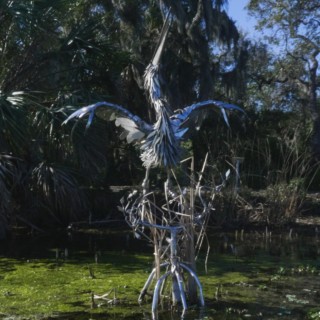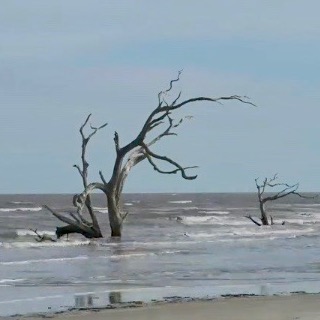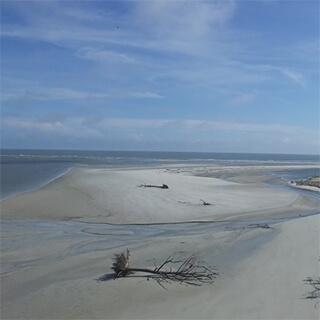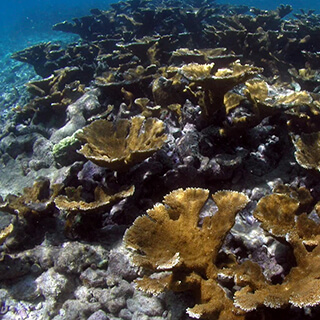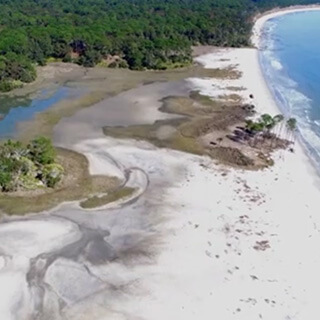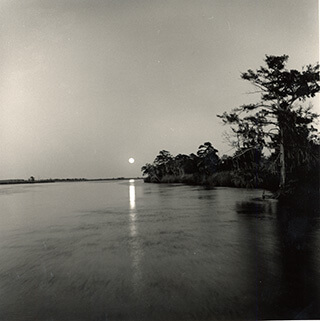Overview
The photography of Florida native Benjamin Dimmitt reveals decades of ecosystem loss in the Chassahowitzka National Wildlife Refuge. In this edited interview with Anthony Martin of Emory University's Department of Environmental Sciences and Steve Bransford, senior video producer for the Emory Center for Digital Scholarship, Dimmitt discusses the making of particular images and the years of photographic work that led to the book, An Unflinching Look: Elegy for Wetlands (University of Georgia Press, 2023). All images are copyrighted by Benjamin Dimmitt and used with his permission.
Bransford: Before we talk about An Unflinching Look: Elegy for Wetlands, can you talk about your personal history with the Chassahowitzka National Wildlife Refuge? And then describe the Refuge in terms of both ecology and aesthetics.
Dimmitt: My first trip there was in 1977 with a friend and my brother. The friend wanted to do some fishing. I had never heard of the place, nor had my brother. We drove up from Clearwater, got in his little jon boat and didn't do a lot of exploring, just fished.
I had never seen any place like this before. I had grown up in the Clearwater–Tampa Bay area, which was then probably three hours or more down the road. There are better roads now. And the swamp, as we call it, was very different from what I'd grown up around. There were many freshwater springs that spilt into the beginning of a river. In 1977, the water was clear, cerulean blue, and no one was living there.
We paddled through hardwood forest. The creek is wide in places because that area is perfectly flat. We slowly got into brackish areas and then went into big, open, less fresh, more salty, but still brackish bays. And that's as far as we got. Then we fished.
It was a very long time ago. It was beautiful. I was accustomed to the coast of Florida having barrier islands or beaches, and there were none. Water, just freshwater, merged right out into the Gulf.
Bransford: In broad brushstrokes, can you describe what the Refuge looks like?
Dimmitt: There were ferns and bromeliads everywhere. The humidity was 100% because of the springs constantly pumping out water. Lots of cabbage palm trees, which is the state tree in Florida. Some cypress and cedar trees remain, although most of them were harvested around 1916. There were trees that I wasn’t familiar with, like a type of holly called Dahoon which had little red berries. Maples. Spanish bayonets or yuccas grew on the islands. On slightly higher ground you might see some oaks.
What I loved most were the grasses that grew in the shallow creeks. You could see them by looking over the side of your canoe. The water was crystal clear. Various grasses and large ferns which had giant leaves. When I would stand in the water and make photographs, the current would move the eelgrass, which is about three quarters of an inch wide and many feet long. Those would brush against my legs as I was shooting. I had to learn to not freak out and not imagine that the eelgrass was water moccasins or gators, and just enjoy the caress.
Bransford: When did you start noticing the deterioration of the Refuge's ecosystem? What were some of these changes and the causes?
Dimmitt: Almost all the causes are saltwater intrusion. And second, for ten or twenty years, is the fertilizer getting into the aquifer. That fertilizer comes from the golf courses upstream at The Villages, which is a very large—it spans three counties—active adult retirement community. I believe they have fifty golf courses which must be beautifully kept. They throw a lot of fertilizer on the golf courses and it ends up in the aquifer. The Chassahowitzka and The Villages are both in the same springshed. The fertilizer goes down into the aquifer at The Villages, it ends up encouraging plant growth in the creeks and in the river. What you get is an increase in algae that grows really fast and then blocks sunlight because these are large mats of algae on the surface of the creeks. The algae mats are the size of a room. No sun gets through them and that kills all the smaller plants, which are the food for the smaller animals and on up the food chain. It's called toxic algae for a reason. It smothers life in the creek. That has been going on as long as The Villages has been there.
Another source of the nitrates is septic tanks that burst and go into the aquifer, and just people's yards, the fertilizer that they throw there. Agriculture also adds plenty of fertilizer to the aquifer. This has been going on longer than the impact of the sea level rise.


I wasn’t aware of the sea level rise until 2014, but if I look at photographs shot in 2010, I can see the beginning of the environmental damage. When you go to a place like this, it's like any forest. There are young trees and plants and mature trees and really old trees. But around 2014, the damage had become inescapable because all the hardwoods had died, the creeks were getting a lot of toxic algae, and the palms were starting to look sad. Sabal palms are the most salt tolerant trees in this ecosystem, so they're the last to die. And in many of my photographs, you'll see very little other than dead trees and palms that are on their way out. The eelgrass and other grasses are very delicate and can’t handle the increase in salt. The mats of algae cut down the sunlight that the grasses need in the creek.
Martin: It's really a combination. You have pollutants coming from the east and you have the sea level rise coming from the west. Those two are coming together in the same place and having this devastating effect.
Dimmitt: Exactly. There is no one single cause of the devastation. When I started on this project, I talked with someone who had a good working knowledge of the state’s water management practices. He had his own views that the state was looking away from or ignoring the impacts of over-pumping from the aquifer. So, yeah, it's a lot of different things. Even melting glaciers can't be denied here. That's what is lifting the water up and sending it from the Gulf up into these creeks.
Bransford: And the depletion of the aquifer is also important. To maintain all these golf courses at The Villages necessitates a huge volume of water. The water flow in the Refuge has deteriorated as well.
Dimmitt: Yes. It's so interconnected. One thing that Susan Cerulean goes into in her essay at the beginning of An Unflinching Look is that there has always been a lens—which is a use of the word “lens” I had never heard of before, but I got it right away—that exists between saltwater coming into the aquifer and the freshwater that's already in there. As water is pulled out for any and all purposes, including for sale as bottled water, the lens moves further and further inland. So you now have salt water and brackish water in the aquifer, in the local drinking water.
Bransford: Tell us about the genesis of this book, An Unflinching Look: Elegy for Wetlands.
Dimmitt: I visited there a lot in the eighties. I had my bachelor party up there. I won't go into that except to state that there were no mermaids involved. I enjoyed photographing it because it was unusual to me. I'd never seen any place like it in Florida. In 2004 I started a new photographic project called Primitive Florida. I felt that I needed to photograph these vulnerable landscapes. I was concerned about things like worsening storms and overdevelopment, and these phenomena that I learned about in college in the early seventies called global warming, climate change, and rising sea levels. Lo and behold, everything that I had learned about was starting to happen. I didn't visit the swamp between 2012 and 2014, but when I arrived at the cabin in 2014, the wetlands were devastated.
I didn't understand. I got in touch with scientists in the Tampa Bay area where I grew up and went to college. I showed them the photographs and they said, “That's saltwater intrusion. That's rising sea levels. You didn't know about that? It’s happening along the Gulf coast up to the Panhandle.”
I didn't know that it was going to be happening so soon. Eventually I got in touch with one scientist, Dr. Matthew McCarthy, whose study is excerpted in the book, and he was excited to see my photographs from water level because he's spent many years downloading satellite imagery and aerial photographs of the coast while he was working on his graduate thesis.
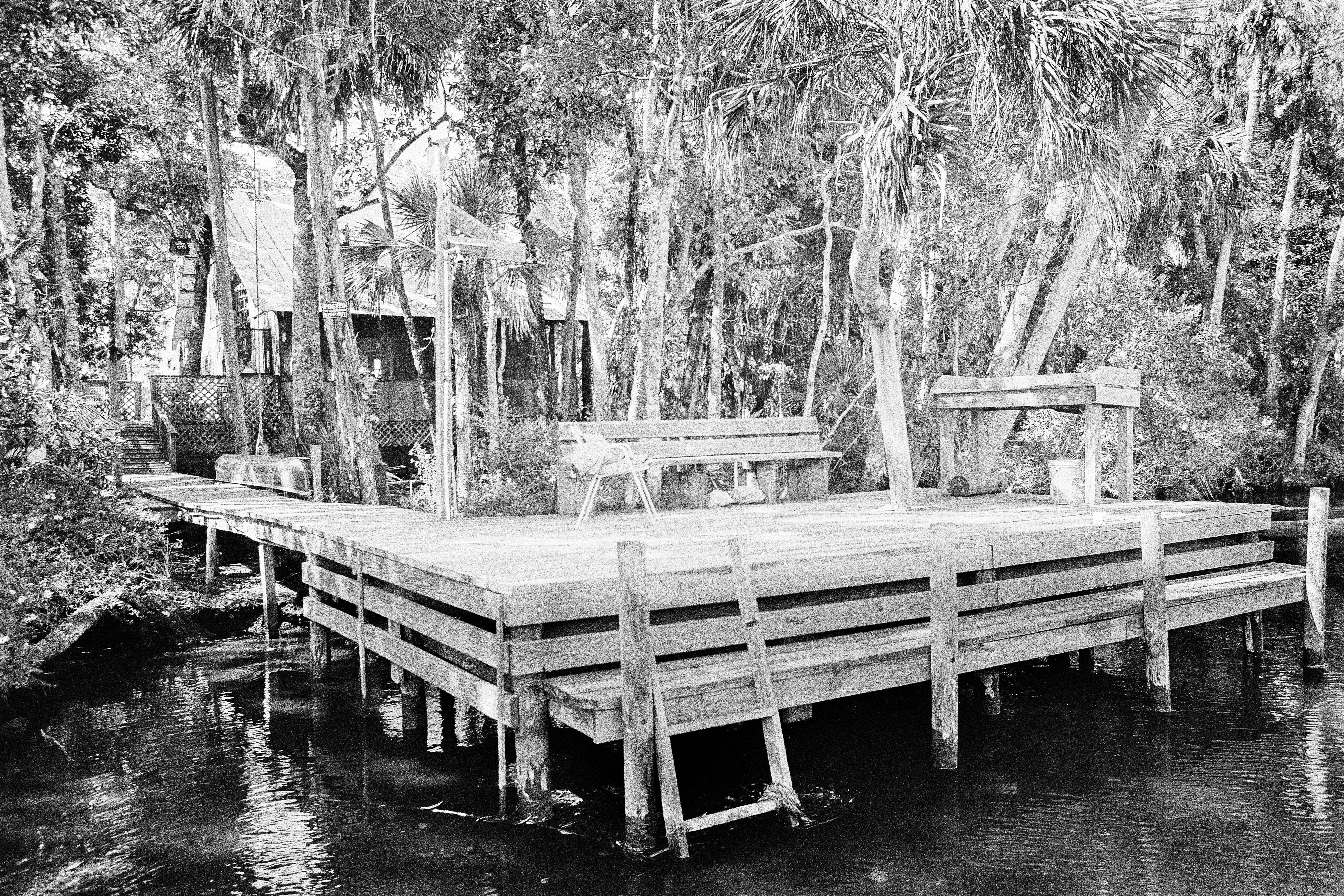

Dimmitt: That's the cabin where I stayed when I visited. My brother was one of the partners in the cabin when it was built; they did a lot of this work themselves. Everything had to be brought in by boat. When the cabin was finished, my brother asked me to take some photographs of the cabin.” He was really proud of it. He said, “I'll take you out in the boat and you can shoot back.” This was the shot I felt was best and I sent it to him. He said to me, “No, you can't see the house.” I said, “Well, bro, you built the cabin in a thick forest” The reason they built the cabin there was because the water is always 70 or 72 degrees. This is right on the creek by a spring, and the house stayed cool in the shade. The first picture (on top) is 1987. The second picture (bottom) is 2021. So that's thirty-four years. That's the same cabin and that's the same dock with some minor improvements.
Martin: This is an example of deforestation that involved no cutting down of trees.
Dimmitt: Absolutely. They wanted the shade. I took the first snapshot and made a lot of prints of it for my brother and the business partner. To reshoot in 2021, it was difficult because I had to find someone with patience to go back and forth and back and forth in their boat while I photographed. I had to figure out what lens I used back in 1987. It took awhile to get something that was good. That's often the case with re-photographic diptychs. It's very time consuming to find exactly where you did the early shot, where you stood, and what lens you used. Usually I did them by myself. But for the cabin shot, I had to rely on someone else to drive me back and forth and shoot a lot of frames.
Bransford: And you still are shooting everything on film, right?
Dimmitt: Yes, the entire project was shot on film. Any images that are square were shot with a medium format camera. When I went to reshoot the 35 millimeter images like this pair, I dug out my old 1980 Nikon F2 and got it cleaned and lubed in Asheville and took it down there. I hadn’t used that camera in probably twenty or thirty years. But yeah, everything's on film.
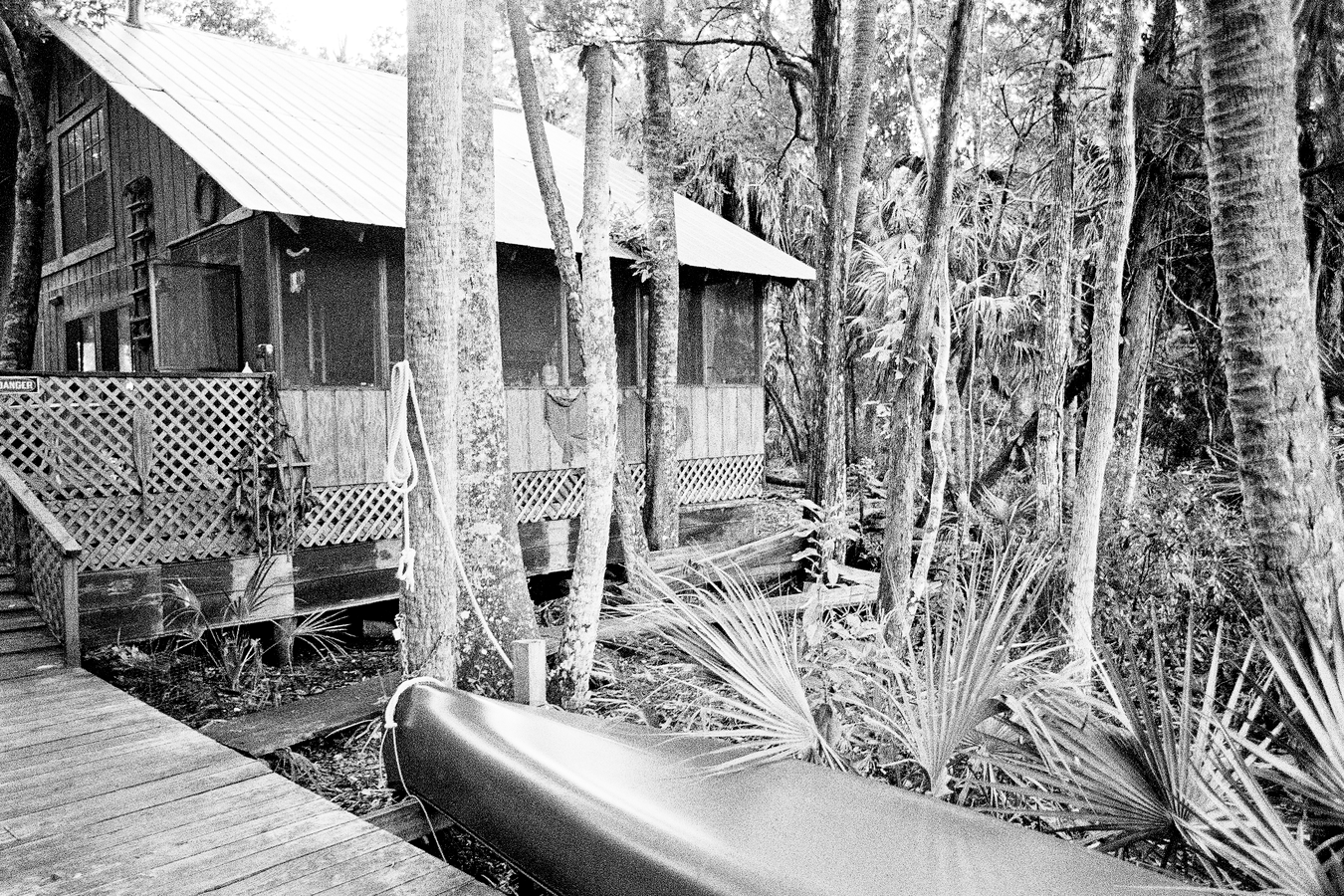





















Dimmitt: That's the walkway from the dock to the cabin. The first photograph was made in 1988 and the second one was made in 2020. The earlier photograph lends itself to a vanishing perspective. And for the later one I made a point to shoot from the same position and with the same lens. It's really amazing how all the canopy, all the forest is gone. The saltwater floods around the cabin now at high tides and during hurricanes.
Martin: I'm wondering if I'm seeing what look like saw palmetto in the top photograph and then beneath it, is that Spartina now?
Dimmitt: Yeah, it looks like saw palmetto.
Martin: My gosh. That's a complete change in the ecosystem. Going from a terrestrial with freshwater influence to now saltwater dominated.


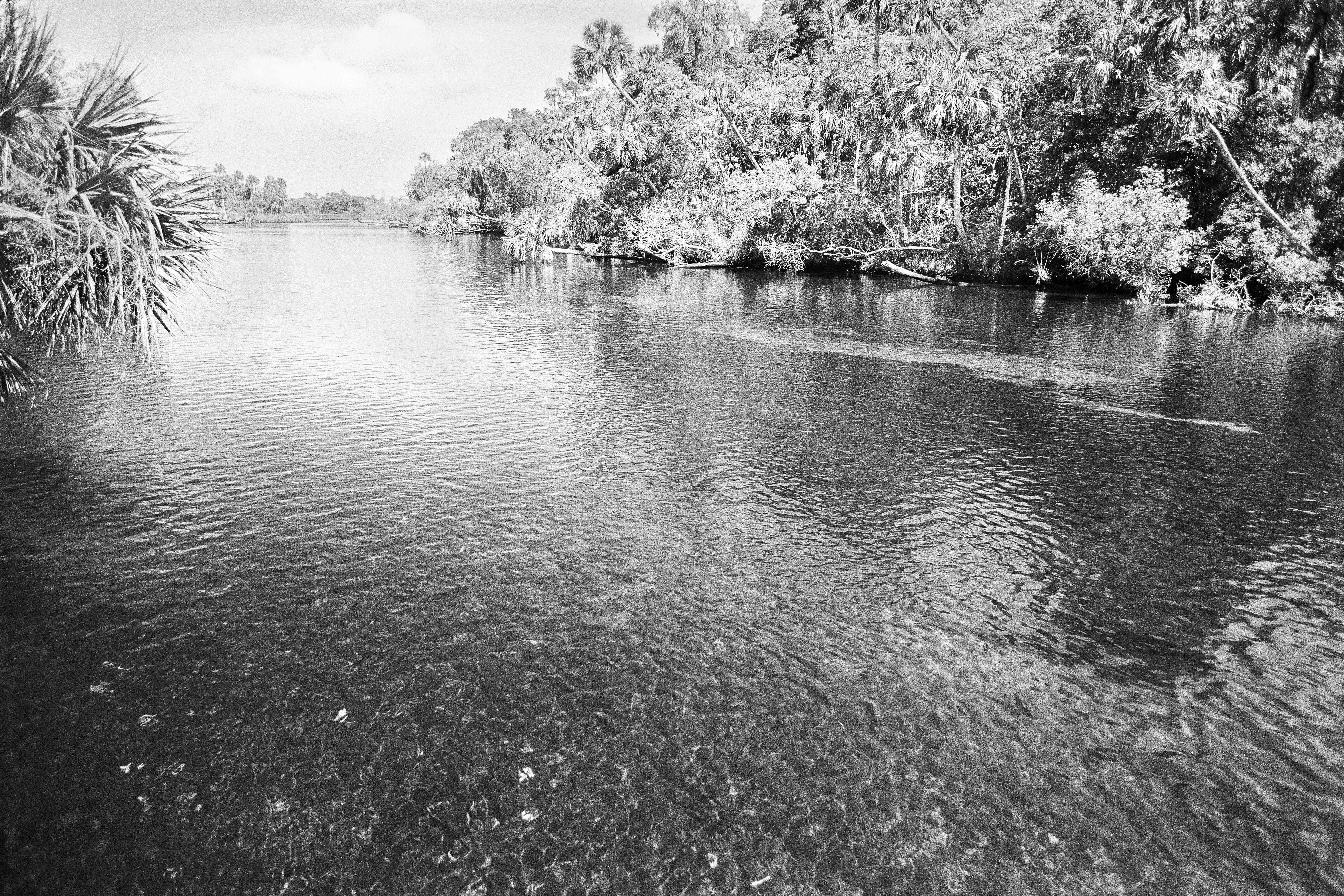

Dimmitt: I believe that this diptych shows the greatest span of time. This is from the dock looking downstream in 1986. And then the follow-up is 2020. It's the greatest span between the first and the second shot. If we were to go there now, half of the remaining palm trees in the back on the right would be gone.
Dimmitt: Next to Pat’s cabin, where I stay, is a neighbor’s cabin that has a boat shed, not a boat house. You climb up through a hole in the roof with the camera bag and tripod. I always worry about getting up the ladder with all my gear. And you can see way upriver and downriver to the Gulf. The left photograph was made in 2006 and the right one is 2022. I did several of these over the years, probably about six or more.

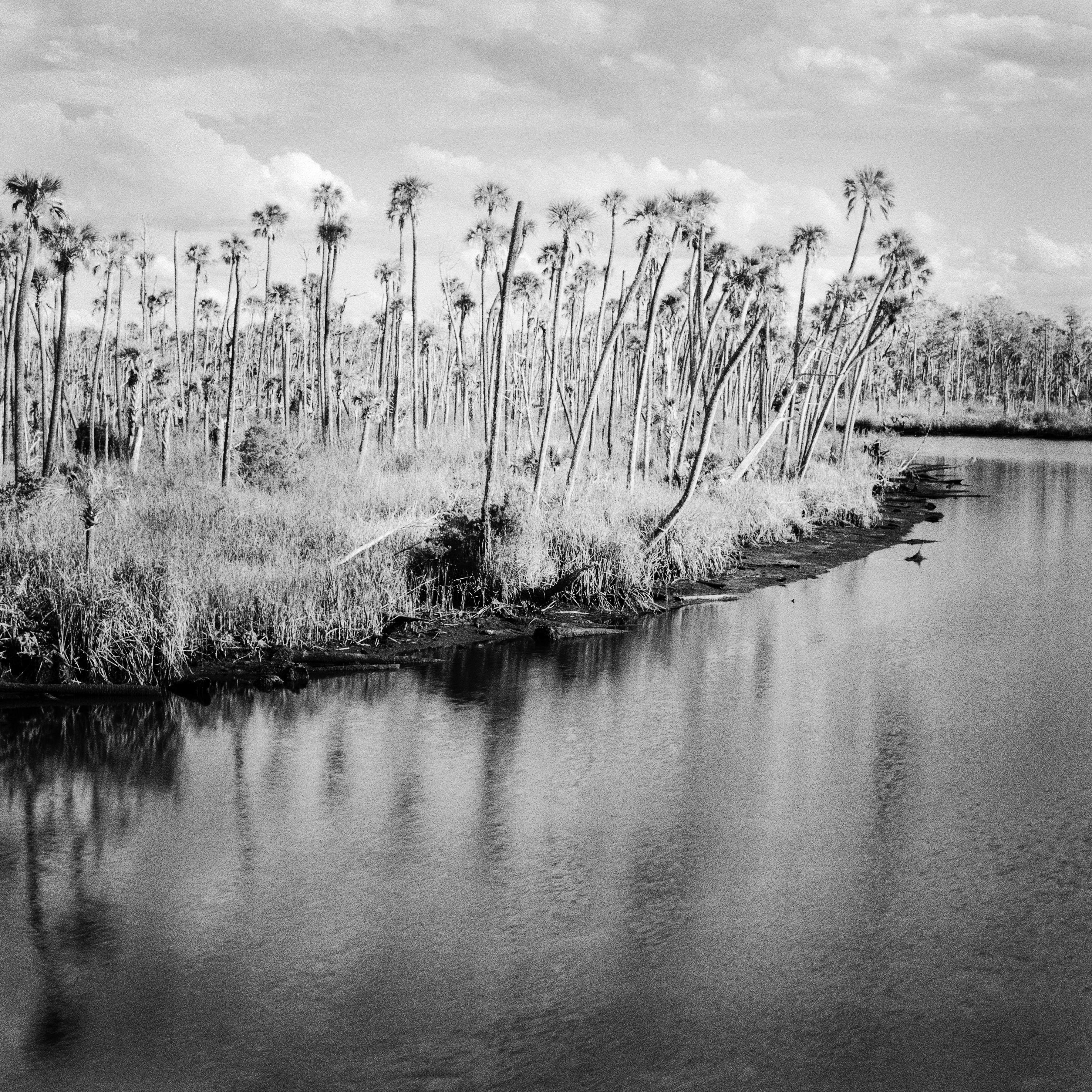
Martin: This is a really good pairing, too, because I think of this as a scientist. I'm a geologist, paleontologist by training. We are used to these really long expanses of time for dealing with environmental change. We say sea level rose, and it took thousands of years. Here, this is less than twenty. And in less than twenty years you've documented this complete shift in the ecosystems as a result of this saltwater intrusion coming upstream and affecting and changing those environments.
Dimmitt: The last time I was there, we had a good show. We saw dolphins or porpoises—I never know the difference from afar—chasing a large school of snook. It's brackish there. It’s a frenzy when the snook get trapped against the shore by the bigger, faster predators. You can't miss it if you're in a canoe or standing on the dock. And then another time, not that many years ago, we were seeing manatees come up and they always get your attention by their breathing sounds: the exhale, and then the inhale. You look out, and they've gone underwater to feed. I've seen them often in that stretch of Crawford Creek, which is where the cabin is and where I did almost all the photography.
Martin: So we're actually getting some marine mammals that are starting to come upstream into that area?
Dimmitt: I know that if they're coming up there, they're looking for food. They could easily be caught or eaten. And the spooked snook are something to behold because they go crazy. They're swimming all over the place trying to get away from the porpoises who are very smart and very fast. It's a bloodbath, but it's interesting to watch.
Dimmitt: This is kind of grim. This is 2004 and 2022.
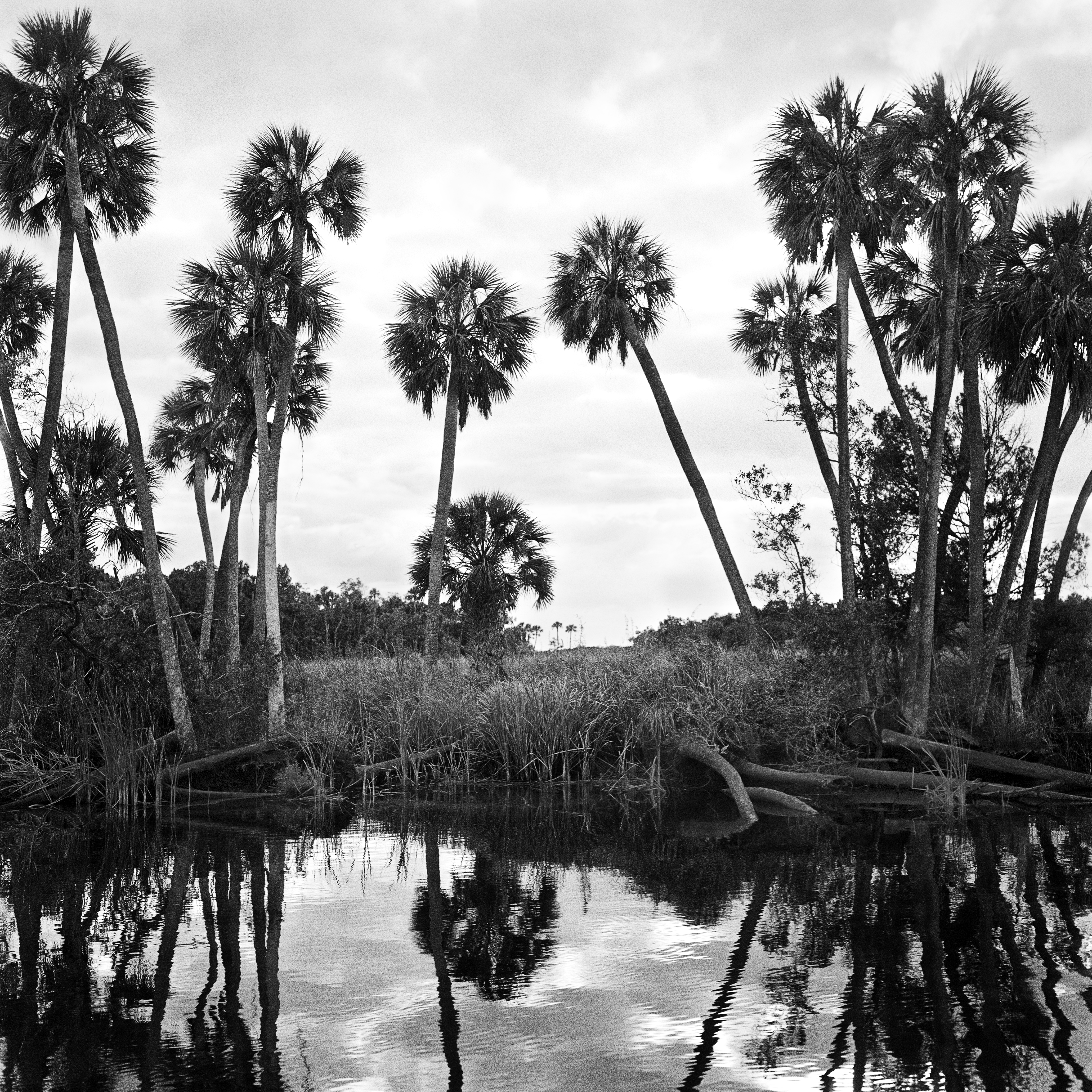
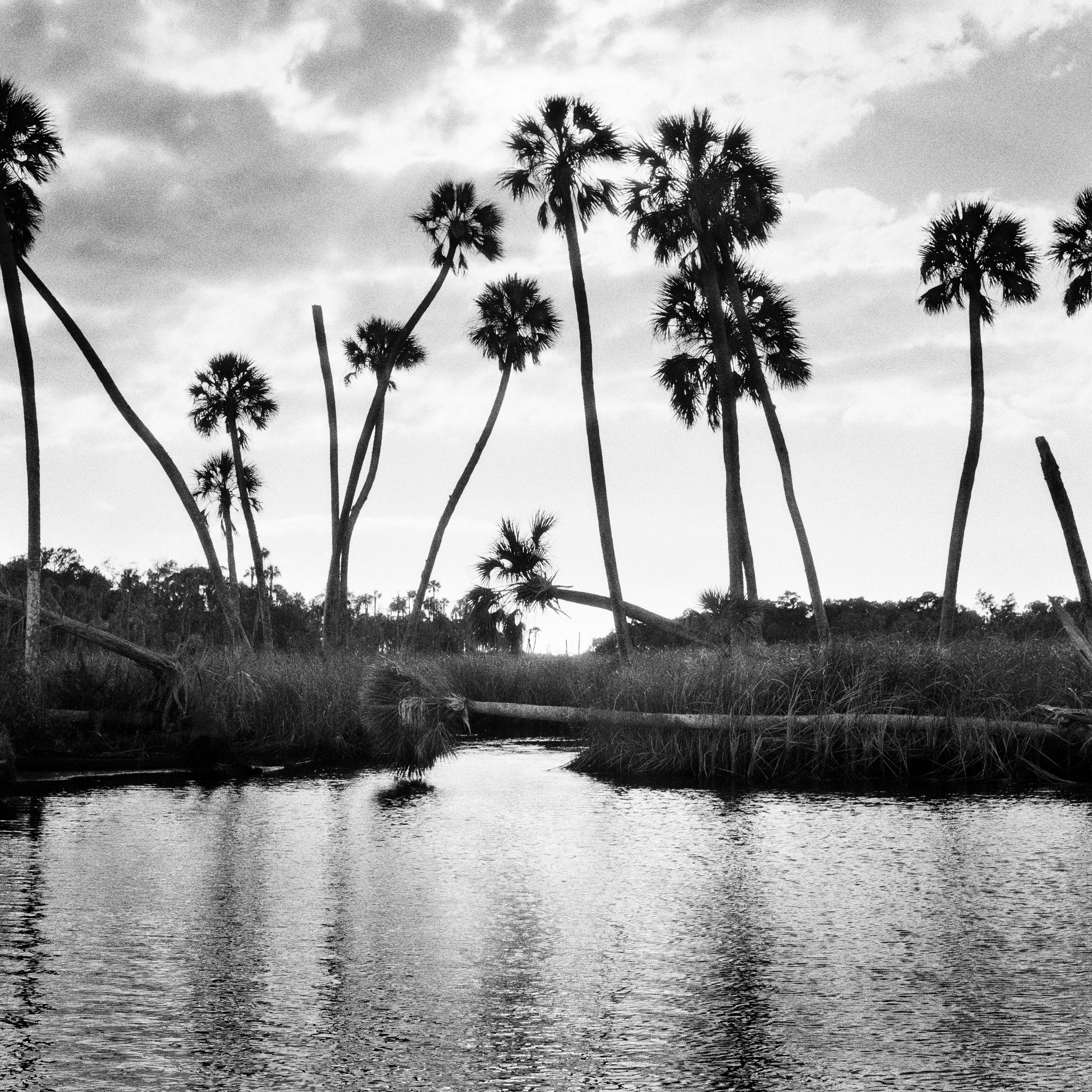
Martin: The total loss of the canopy is so striking to me. In those ecosystems, you originally had shade-tolerant plants and, of course, animals that would have been living in those communities. Then with the loss of that canopy, now you have all that sunlight pouring into those areas and heating them up, as well as the saltwater intrusion. All that is totally changing the ecological communities. And again, this happened in less than twenty years.
Dimmitt: This location is a protected stretch of creeks, maybe twenty or thirty yards out of the wind. What you see between these two photos is not a dramatic difference. My host told me that when fishermen would return in the evening, they'd go up into the grasses and clean their fish, which is why it’s called The Kitchen. And then they can get back out to the Gulf and go back up to the town of Chassahowitzka and pull out or go home. I shot the first one probably in 2004 without a tripod, which is always dicey, with a big, heavy, medium format camera. I kind of like that scene in 2004. When I went back to re-photograph it, I'm again relying on the patience of a friend and sometimes that patience runs short because I'm saying, “No, closer, no, further back.” And you go back and forth in front of it a couple more times, and there's nothing in it for the boat owner. But that was the best I could do. And everything is shot on film, but when you prepare files, when you get the images ready for the publisher, you have to get scans. So I'm working in Photoshop on scans of these negatives that I shot and printed many years ago, and I'm seeing things that I hadn't seen in a long time, and I'm looking at the difference in the two of them side by side and seeing a lot of small differences, and then way off in the background seeing other differences, and the edges of the islands on the left and right. There's some deforestation in there as well. It's a photograph that I enjoy, but it doesn't pack the punch that these other ones do.
Martin: Right. That was one of the aspects that I appreciated is that you had to toggle back and forth between each of the images to appreciate the amount of change that had happened there. And some of it is subtle. So it's something where, if you just had the second photograph, the later photograph by itself, someone who doesn't know that place would say, 'What do you mean, it looks fine, it's totally fine. It's not like there's a condominium or a development there. What's the problem?'
Bransford: Speaking photographically, did you have some compositional strategies of how you wanted to depict the Refuge? Some images have very strong diagonal lines, some obviously have strong vertical lines with the trees, sometimes downed trees dissect the frame horizontally. Other images don't have strong leading lines. The ones with algae or grasses are more abstract, ethereal. Sometimes there's a curved tree in the middle of the frame that grabs our attention or a log in the foreground in the water. Did you have certain compositional strategies of how you wanted to depict the refuge?
Dimmitt: Not at all. In some cases, I am walking around, where it's dry enough, in mud shoes and just looking or in some cases checking to see what some place looks like now. But I don’t have a predetermined way to shoot. That would really bore me. I did almost all of the newer work since 2004 with a square camera. There are only so many things you can do with a square medium format camera. I've had someone tell me it's evident that I had some sort of preconceived notion or was shooting a certain way but that’s not the case. I spent many years on this project. I had to keep it fresh. That might mean working on re-photographic diptychs one day and going on a long paddle to photograph some place new the next day.

This one is a favorite, and I was asked at length about it: how premeditated is this, that sort of thing. We discussed it at the Asheville Art Museum. One of my authors, Alison Nordström, who wrote the book’s long essay on the photography, had this in her slides, and she was saying all sorts of things about it that were wonderful and flattering. And my memory is that it was beautiful. It was very straightforward in that these were palms that had washed up on the edge of a savannah. I was on a narrow dock, and I couldn't move forwards or backwards. So I was completely constricted in how I could compose it, except to change the lenses. I made what I thought was a good photograph. Alison loved it. I didn't mention at the museum book talk, but I feel it now and see it now. It looked like the Pieta to me, it looked like the Virgin Mary with Jesus in her lap. I spent time in Florence in the seventies studying Renaissance painting, etching, lithography, and sometimes all that old Italian Catholic imagery stays in your head. And you’re not even aware of it until later.
Dimmitt: This is another one of those images that was really difficult to photograph. I love it, but it was so busy and there was so much going on. It took a while, maybe twenty or thirty minutes to create some sort of order out of this chaos.

Martin: Something I appreciate in terms of the documentary aspect of this sort of photograph is that the reflection is actually bringing out the sky better. You can see the clouds and the gaps between the clouds that are only implied in the actual sky part of the picture.
Dimmitt: I was asked if I always make my skies white. There are various things I could have done here and I did do in this case, and that's to use a deep yellow filter to try and get some tone in the sky. But it was a very bright sky and there's not much you can do to get tone in it. To further answer your earlier question, I don't have a preconceived notion. This was just very difficult to compose. It's a complicated image visually but I’m very happy with it.
Bransford: You mentioned Alison Nordström, she talks about the opportune slipperiness of these photographs in the sense that they simultaneously inhabit the worlds of art, science, and social action. Was this or is this your intention? Did you come at the project initially from an art photography standpoint and realize gradually that the images also have scientific and even political appeal?
Dimmitt: I'll almost give you a straightforward answer and say yes. And then there's a but. As I mentioned, I started shooting there in earnest in 2004, and I was just photographing something that I thought might disappear or that I just liked an awful lot. And the more I poked around, the more time I took when I went there and paddled in the various parts of the swamp, the more I loved it. And again, I'm from there. This is my native landscape, so I was very happy to be doing what I was doing. And then climate change arrived, and I didn't really change my approach and become a different sort of photographer. I just photographed the impact. There was nothing undamaged. The impact was all encompassing. It was everywhere. You really couldn't escape it, and it got worse every time I went. Someone recently asked me how how many rolls did you shoot? How many times did you go down there? I moved to Asheville in 2014, and that's when I first discovered that the rising seas were starting to do serious damage. The tally I got when asked was around twenty-five trips down there in the eight years that I worked on the project.
I was doing landscape photography. That is what I do. I just happen to like to photograph in wetlands because that’s my native environment. That's my native landscape. I grew up in Clearwater on the bay. I'm working now on a project about mangroves. When I was in Florida last month, I was shooting at Weedon Island in a big, beautiful mangrove forest. That's the kind of subject that I like. The interpretation is up to the beholder.
I imagined that these photographs were good enough that my gallery in Tampa would be interested in exhibiting them. They said they weren’t going to be able to sell them, but they would exhibit them. So we did. And only two or three sold. I was eventually told it should be a book. So I got in touch with the University of Georgia Press, and the director was very excited about the work.
The book then gives you an opportunity to create an editorial viewpoint. And to me, they didn't have an editorial viewpoint. They were just a document of a place that I had made photographs of that was becoming ruined by rising sea levels. Learning about the causes from Dr. McCarthy was something that made me become a little more activist about it, and also learning about my subject and doing research. But the research didn't start until I got a book deal. Learning about The Villages and learning about the state's water management, or water mismanagement, made me even angrier, and that became something my editor convinced me to write about—my feelings. That's why my epilogue is sharper than the rest of my language.
Bransford: I'm glad you mentioned the epilogue. In it, there are the two anecdotes. One of you visiting what I think is the oldest and biggest tree in the refuge and your speculation about what's going to happen to it. And then also the wonderful anecdote of you paddling and not hearing any leaves rustling but hearing the woodpecker sounds. Could you recount those two anecdotes?


Dimmitt: I'm still surprised that the editor got those two things out of me because writing is not something that I do well or do comfortably. The last remaining old growth cypress tree is not the last one in the swamp, but the last one that anyone could direct someone to. It happened because I asked my host down there, Pat, if he could take me there. He said, “Yeah, but we will have to go to the property owner first.” And I said, “That's fine.” So we did that, and then we walked off in the direction of the tree and I'm relying on Pat. He's been there multiple times. And I'm looking up, and I'm waiting to see some old growth tree.
I practically walked into it. It’s the photograph which has a lot of palm fronds and shadows on its fat trunk. I stopped there and photographed. It doesn't show the upper part of the tree, it just shows the trunk, which is huge. I couldn't really see the tree trunk. I almost walked into it because it was somewhat camouflaged by all of its neighboring palm trees, which were small. I imagined that's how it had lived so long, because it had been unrecognizable. And anyone who is looking for cypress trees would have passed it by because its top had probably been blown off by lightning. And I made a couple of photographs of the tree in the shadows, and then backed away and got a different lens and photographed the top, which is a mess. It may still be there. I think that photograph was done in 2021, but it is really close to a creek and all the creeks are becoming saltier. And that may be what kills that tree. It survived the loggers in 1916, and it probably is not going to survive this.
You mentioned something about sound, and I will tell you that the last photographs I showed you of the palms in the creek where we discussed filtering for the sky and, that sort of thing—if I was there maybe twenty or thirty minutes composing and making the photograph and when I'm doing that, I have everything turned up all the way. I am looking as hard as I can. I'm trying to compose something that reaches into me, is compelling compositionally, all the rest of it, where am I standing, that sort of thing. Sinking up to my calves in mud. And I'm seeing everything, and I'm hearing everything. And when you asked about the woodpeckers, I chuckled because when I get back to the cabin at the end of the day, or if I’m here in the mountains and I get back to the car after a long hike, I can tell you every single thing I heard. I can tell you everything I saw. My sniffer's gone, so I can't tell you every smell. Being in the canoe, paddling around, feeling the breeze. It was a hot day in December. Losing control of the canoe in a breeze, and then I got pushed over to the side of the creek. I dropped the anchor and sat there, there was not a photograph for me to take where I ended up, but I could hear not just one woodpecker; I could hear many, many woodpeckers banging away at the all the dead trees, all the dead hardwoods surrounding me. And it was really disheartening. It was an indication that some bird's happy and there's a lot of food for all the woodpeckers now, but that's just another way in which we learn how bad the ecosystem loss is.
Martin: That caught my interest because the last couple of David Haskell's books have dealt with sound. One of them is The Songs of Trees, and Sounds Wild and Broken is his most recent book about how there are not just landscapes—and what you're doing is documenting landscapes that, of course, are waterscapes as well—but there are soundscapes. So you have the visual aesthetic that is intrinsic to your photography, but sometimes with a picture like that, I, as somebody who goes into those kind of environments, experienced the same thing you did, I also hear the sounds when I look at the photograph. And I'm realizing that it's not just visual, that there are other senses that are being engaged with these places and how climate change and sea level rise, pollution, all of these factors are also affecting those other ways we sense the world around us.
Dimmitt: If I'm at the swamp house with my host and his family, if there is a porpoise–snook battle going on, we always go out to the dock and watch. And you don't see it if you're inside the cabin with all its screens. If you're inside, you hear everything outside. You run out and engage with it. It’s nature at its most brutal. I went to school at Eckerd College near Lake Maggiore, and the sound of ospreys chirping for minutes after minutes after minutes is something I grew up with. It resonated with me.
Bransford: Is there anything else about your book that we didn't cover that you'd like to talk about?

Dimmitt: This photograph of fog on the creek closes my essay in An Unflinching Look: Elegy for Wetlands. Something you feel when you're there. It's 100% humidity. If you shoot in the winter, which I prefer because the light is better in the winter and it's not as hot, then you're going to get fog because at night it cools down. And I just walked out of the cabin and down to the edge of the dock, and that was in front of me. That's a palm that had been alive, well, probably four or five years prior. And it was already hosting plant life of its own. This is my first book. Working with an academic press, they didn't give me any direction. I was completely on my own to make the image selection and to sequence it and I came up with the idea of the gatefolds. They were wonderful to work with, and the designer did, I thought, a beautiful job.

Dimmitt: This is one of the last photographs I took in the swamp. It was the same day that I went out and heard all the woodpeckers. What has stuck with me is this whole place was a thick tropical forest, and now it's nothing. This is Spartina? Is that what the grasses are?
Martin: That's what it looks like. Smooth cord grass.
Dimmitt: There’s another grass that’s round.
Martin: Juncus. That’s also a saltwater indicator.
Dimmitt: Often I will shoot from the canoe handheld without a tripod. It’s not easy to do. And I saw this and I thought it was beautiful. I didn't think about what purpose it would serve in a book as propaganda or beauty or science or any of that. I just shot it. But after I finished the photograph, I realized that I had been fighting logs and tree trunks in the creek the whole time, and the image I just called Impassable Creek. That's because you can't paddle in these places anymore because creeks are so full of dead trees. There's no clearance. And it was like being shackled. There are so many corpses that you can't move freely. Someone who wrote about my project wrote that it reminded him of a Civil War battlefield with corpses everywhere. And this was the first time, in 2022, when I was finishing the book, that I felt that I couldn't move in the swamp.

Dimmitt: When I would walk in some of the drier places, I would just be checking in. And one of the things that caught my eye on this day was that saplings were dying. This is kind of a mess as a photograph, but that's what you see when you're walking around. When it’s too salty for palm saplings, then it's really too salty.

Dimmitt: The earlier photographs in the book are photographs of a place that was pristine and exotic. Photographs of things that I found beautiful and unusual. However, I gradually started to photograph death and destruction on a very broad scale. It just kept getting worse and worse. And it will continue to get worse and worse. Hurricane Idalia had a big impact down there. I don't even want to go see that. I had to adapt to shooting environmental destruction. I didn't know how to do this. I get asked about beauty. One thing I didn't want to do was to suddenly go from taking photographs of some place I found compelling and beautiful to using my camera to make ugly photographs or to make these wetlands look bad. When I was doing the event at the Asheville Art Museum with Alison Nordström recently, she said to me, this is a beautiful photograph. Just one of a dead palm in the river. I'm saying to myself, this image is brutal. This is straightforward damage. And it was, again, shot from a canoe, which makes it difficult to do. The creek bottom was vey soft so I can’t get out and walk. And I did the best I could. It's not a good negative, but I'm grateful that I don't have to print much of these images for exhibits because no one would want to show this work in an exhibit. But this is as straightforward a photograph as I can make. I don’t recall making any effort to photograph it beautifully. And I was surprised that Dr. Alison Nordström thought it was beautiful.
Bransford: Is there a tension there of creating beautiful images of things that are brutal and unsettling? Are they mutually exclusive?
Dimmitt: For me, there isn’t a conflict. I don’t feel that they are mutually exclusive. I guess I gave an insight into that a moment ago. I went from photographing a place that I felt was beautiful to photographing its ruin. It’s my native landscape. These are forms and shapes and trees and brackish water that I grew up with in Clearwater. We lived by the bay and there were roots of large mangrove trees that had died in a freeze long ago. They stayed there on the sand bars for decades. So, I guess I got acclimated to seeing a certain amount of death in my surroundings.
I don't know how to make ugly photographs but I do know that a beautiful photograph encourages a viewer to engage with it. I simply continued using the same sense of aesthetics that I brought to the swamp when I started photographing there decades ago.
I made a commitment to this place when I began this project in 2014. I like to honor my subjects. My goal all along has been to make compelling photographs. The book is about bearing witness to a tragic loss, saying farewell to these beautiful, complex wetlands and making it known that this is happening now along low-lying coasts all around the world and will only get worse. 
Recommended Resources
Text
Davis, Jack E. The Gulf: The Making of an American Sea. New York: Liveright, 2017.
Davis, Jack E. and Raymond Aresnault, eds. Paradise Lost? The Environmental History of Florida. Gainesville: University Press of Florida, 2005.
Pittman, Craig. Paving Paradise: Florida’s Vanishing Wetlands and the Failure of No Net Loss. Gainesville: University Press of Florida, 2009.
Whitney, Ellie, D. Bruce Means, and Anne Rudloe. Florida’s Wetlands. Florida’s Natural Ecosystems and Native Species. Vol. 2. Sarasota, FL: Pineapple Press, 2014.
Web
Dimmitt, Benjamin. Photography of the Natural Environment. https://www.benjamindimmitt.com/.
Michael, Holly and The Conversation US. “Climate Change Is Making Saltwater Intrusion Worse in Coastal Areas: A Hydrogeologist Explains the Shifting Balance Between Fresh and Salt Water at the Coast as Sea Levels Rise.” Scientific American. October 13, 2023. https://www.scientificamerican.com/article/climate-change-is-making-saltwater-intrusion-worse-in-coastal-areas/.
NatureServe. LandScope Florida. 2024. http://www.landscope.org/florida/.
Stys, Beth, Tammy Foster, et al. “Climate Change Impacts on Florida’s Biodiversity and Ecology.” Florida Climate Institute. 2017. https://floridaclimateinstitute.org/docs/climatebook/Ch12-Stys.pdf.
US Department of the Interior Fish and Wildlife Service Southeast Region. Chassahowitzka National Wildlife Refuge Comprehensive Conservation Plan. September 2012. https://ecos.fws.gov/ServCat/DownloadFile/18993.
Yoder, Kate. “Florida Bill Would Purge State Laws of Climate Change Mentions.” Grist. March 25, 2024. https://grist.org/politics/florida-erasing-climate-change-laws-desantis/.


